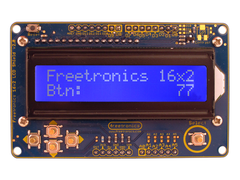Whether you're looking for a basic Arduino project to share with some youngsters, or getting in early on the festive season - this project will be of interest. By mounting thirteen LEDs and matching resistors on some prototyping board, the designer has created an illuminated LED tree that could be useful as a decoration of sorts, or another form of data output.

To get started, head over to the project website for code, construction advice and inspiration. And we're on twitter and Google+, so follow us for news and product updates as well.
When experimenting with your Arduino board by interfacing with all those LEDs, it can be difficult and time consuming to mess about connecting wires of various sizes to the board. As you can see the designer has chosen our Freetronics Terminal Shield for Arduino - which neatly solved the problem:

Apart from having a larger than normal prototyping area, there are terminal blocks for every Arduino pin, three LEDs for general use and a reset button on the shield. Great for experimenting and fast I/O connections - so order yours today.




















